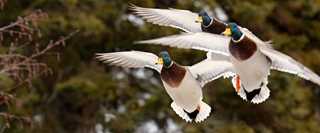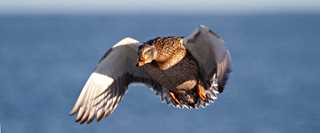The Myth of the Northern Mallard
Do these fabled birds actually exist?
Do these fabled birds actually exist?
As the hunting season progresses, we inevitably hear waterfowlers exclaim that the northern mallards or red legs have arrived! These fabled birds, which supposedly nest in Canada and Alaska, are larger than mallards raised in lower latitudes and, because of their size, are the last to migrate south in the fall. They can also be identified by their gaudy breeding plumage and telltale reddish-orange legs. In reality, it is impossible to determine a mallards geographic origin based on its physical characteristics. Whether its a local bird, or one from Alaska, all mallard drakes eventually develop colorful breeding plumage, although the timing varies among individuals.

Photo Michael Furtman
Like the growth and hardening of a bucks antlers, drake mallards acquire their brightly colored feathers, legs, and bill in response to an increase in testosterone. These hormonal changes are triggered by decreasing day length in late summer. Ducks begin to pair up in the fall, and because drakes must compete for less numerous hens, they develop their breeding plumage as early as their body condition allows. Being fat and brightly colored gives drakes a decided advantage over smaller and less conspicuous males.
Age and nutrition can influence when a drake mallard develops breeding plumage. Older males tend to ramp up their testosterone level faster than younger ones. No matter the age of the drake, however, he needs to have access to an abundance of high-quality food to fuel this seasonal transition.
For hens, acquiring a strong, healthy mate is crucial. During winter, females must feed heavily to acquire enough nutrients to complete the winter molt and to prepare for the rigors of the spring migration and breeding season. Having a mate by her side allows her to feed without being interrupted while the drake watches for predators and wards off competing pairs.

Photo Michael Furtman
After selecting a mate and spending the winter together, the hen leads her drake back to the area where she was hatched. It is the hen that has a strong homing instinct, and the drake is only along for the ride. As a result, a drake mallard that was hatched in Iowa might find himself in Alberta the following spring after following his mate north during the spring migration. Thanks to this mixing of hens and drakes on the wintering grounds, its impossible for a large migratory population of northern mallards to exist.
That said, the myth of the northern mallard has some basis in fact. As the fall migration progresses, and more birds arrive in your area, many of the mallards that you see in the marsh will indeed be from farther north. Once they show up, theyll hang around with the mallards already in your area, some of which may have been raised there. When you do bag a big, fat, red-legged drake, hell be a sight to behold. Call him a northern mallard if that suits you. But realize that he might just as easily have come from a wetland down the road.
Learn more about mallards.
Ducks Unlimited uses cookies to enhance your browsing experience, optimize site functionality, analyze traffic, and deliver personalized advertising through third parties. By continuing to use this site, you agree to our use of cookies. View Privacy Policy